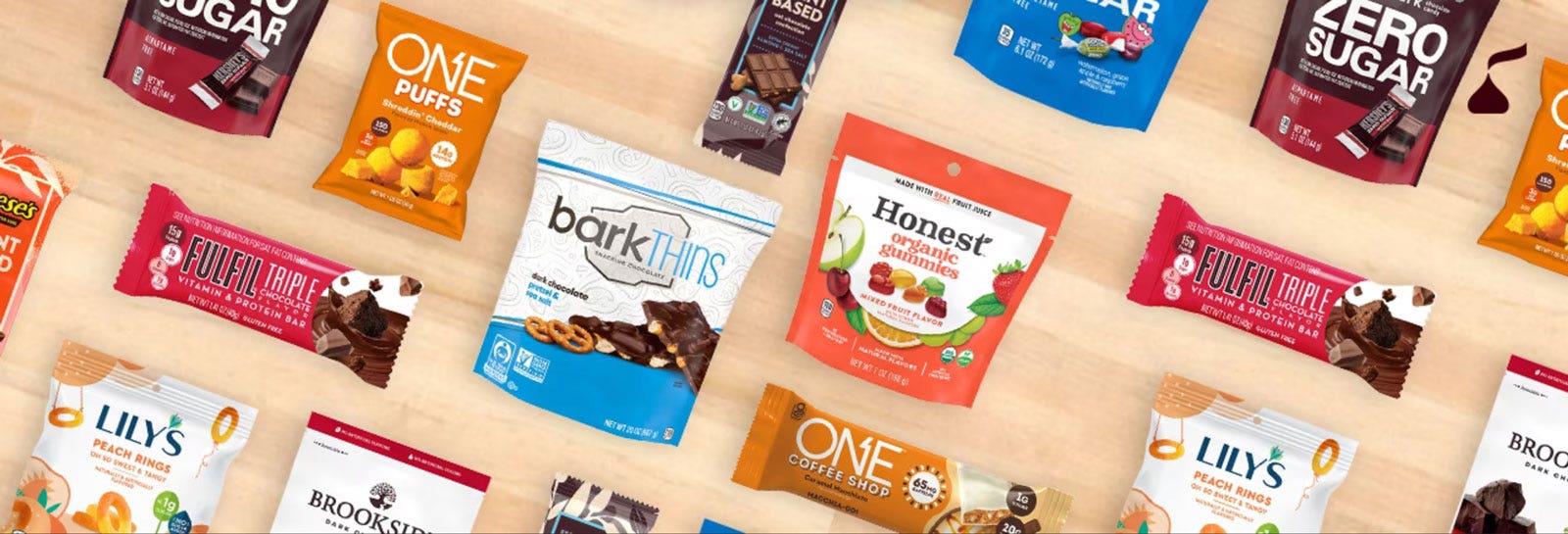Hershey first introduced its better-for-you confection (BFY) strategy in 2021 with the relaunch of our sugar free platform. As we evolve into a leading snacking powerhouse, we aim to reach more people, across more snacking occasions, including more options in BFY confection. Our growing portfolio includes no sugar added and zero-sugar items, protein bars, plant-based products, and brand collaborations to offer more choices to consumers who are looking to incorporate wellness into their snacking.
This strategic decision stemmed from research from our consumer insights team, which works to understand changing needs of our consumers so that we can respond with products and packaging to meet their interests and help our retail partners do the same. And right now, we’re seeing that wellness is top of mind. Our research shows that,
- 71% of consumers say that living a healthy lifestyle is important
- 78% of consumers believe that eating healthy is an important factor in overall health
- 70% of consumers are trying to reduce their sugar intake
- 62% [i] of consumers are looking to add protein to their diet
The idea of wellness is broad and spans from mental and emotional to physical health. We make food choices throughout the day depending on the need and occasion. Sometimes we reach for a fully indulgent treat that meets our mental or emotional wellness needs. At other times we seek better-for-you alternatives of our favorite brands— like those with less sugar, more protein and plant-based ingredients. Consumers want both BFY and indulgent snacks and make trade-offs between BFY and indulgent for different occasions, creating a bow-tie effect on each end of the spectrum.
Gone are the days when “healthy eating” simply means eating more fruits and vegetables. With emerging innovations like weight loss drugs and pills, consumers are exploring new ways to live a healthier lifestyle. Today, consumers are finding ways to incorporate wellness into snackingthey enjoy, and Hershey is working hard to support that journey in different ways.
Sugar management Nearly three in four consumers are trying to limit or avoid sugar in their diet [ii]. To offer them choices they can feel good about, we relaunched our Zero Sugar line with new branding and packtypes for iconic brands such as Hershey’s and Reese’s. Since 2021, sales have tripled. Also in 2021, we acquired Lily’s, which specializes in no-added sugar confectionary products made with Stevia, an alternative sweetener. We have new product launches planned for Lily’s, including new chocolate, baking chips and gummies that will give consumers exciting ways to enjoy this brand. In spring 2023 and in partnership with The Coca-Cola Company, we launched Honest Organic Gummies, made with Honest organic fruit juice and natural flavors and no high-fructose corn syrup or artificial sweeteners.
Protein occasions As much as consumers want to decrease their sugar consumption, they want to increase their protein consumption. According to Grand View Research, health-conscious consumers are driving growth in protein supplement consumption, which is expected to expand at a compound annual growth rate of 8% from 2022 to 2030 [v]. Consumer insights have guided our investments here, too. In 2019, Hershey purchased protein-bar maker ONE™ Brands, and is also an investor in Dublin-based FULFIL; we’re focusing on bringing the brand’s protein bars to North America and launching protein-packed ONE™ Puffs. With both brands, consumers can enjoy a delicious protein snack that also aligns with their health goals.
Plant-based options The vegan chocolate market is exploding, with an expected compound growth rate of 14.8 % from 2021 to 2028, according to Grand View Research [iii]. To put that into context, sales of total chocolate grew at a 5.2% compound annual growth rate from 2017 to 2022, according to IRi [iv]. The Hershey Company recently launched nationwide two plant-based confections: Hershey’s Plant Based Extra Creamy with Almonds & Sea Salt and Reese’s Plant Based Peanut Butter Cups.
What retailers need to know As shoppers look for BFY alternatives during their wellness journeys, retailers can harness their basket-building potential. BFY confection has seen accelerated growth for four of the past five years, and there’s more room to grow. BFY confection is under-represented compared to other center store categories. And all shoppers of BFY confection also purchase conventional confection; there is no exclusivity. Shoppers who are buying BFY are also buying a variety of other brands, both within confection and across snacking categories.
We seek to place our portfolio in the center of the aisle to be at eye level and arms reach across classes of trade. BFY products that are on feature or display see the greatest dollar lifts across all classes of trade. Finally, our shopper testing has found that placing BFY confection nearer to conventional confection helps bring attention to these items, which leads to greater conversion.
At its core, the success of our BFY strategy is grounded in listening to consumers, proactively identifying market opportunities and leveraging key partnerships and acquisitions to create more moments of goodness by offering consumers more choices for more occasions.
[i] 2021 IFIC report
[ii] IFIC 2022 Food and Health Study
[iii] Vegan Chocolate Confectionery Market Size, Share & Trends Analysis Report By Product (Molded Bars, Chips & Bites, Boxed), By Distribution Channel (Online, Offline), By Type (Dark, Milk), By Region, And Segment Forecasts, 2021 – 2028. Grand View Research, 2021.
[iv] IRi, Total Chocolate category dollar sales, CAGR, 2017-2022
[v] Protein Supplements Market Size, Share & Trends Analysis Report By Source (Animal-based, Plant-based), By Product (Protein Powder, Protein Bars, RTD), By Application, By Distribution Channel, By Region, And Segment Forecasts, 2022 – 2030. Grand View Research, 2021.
